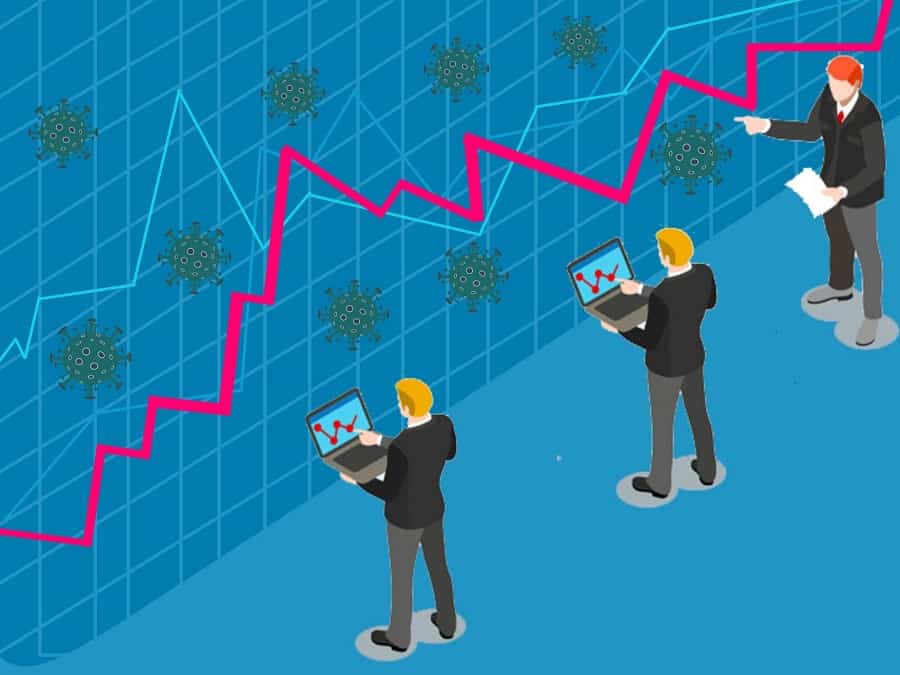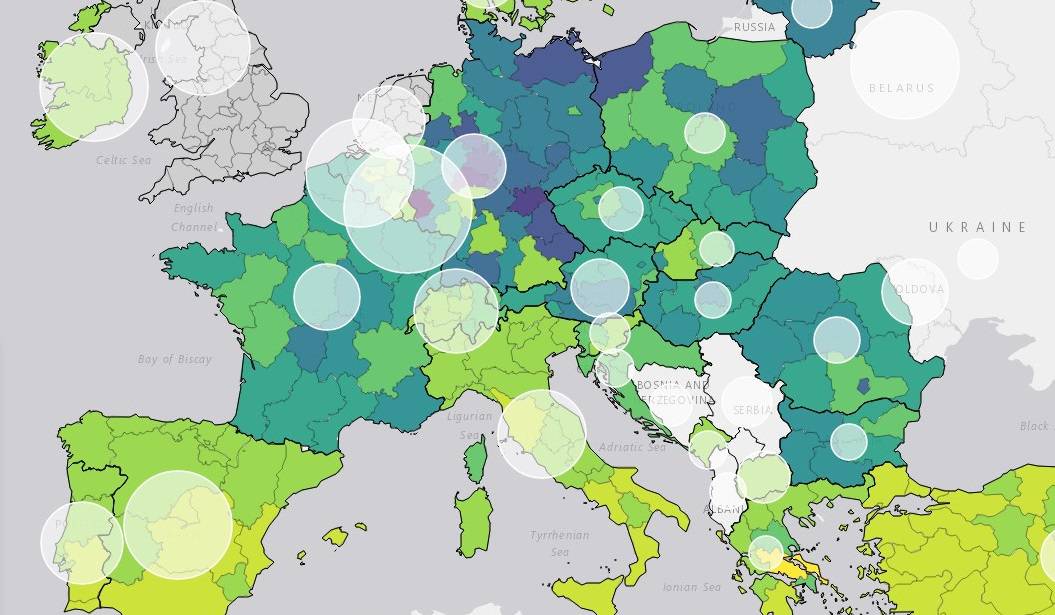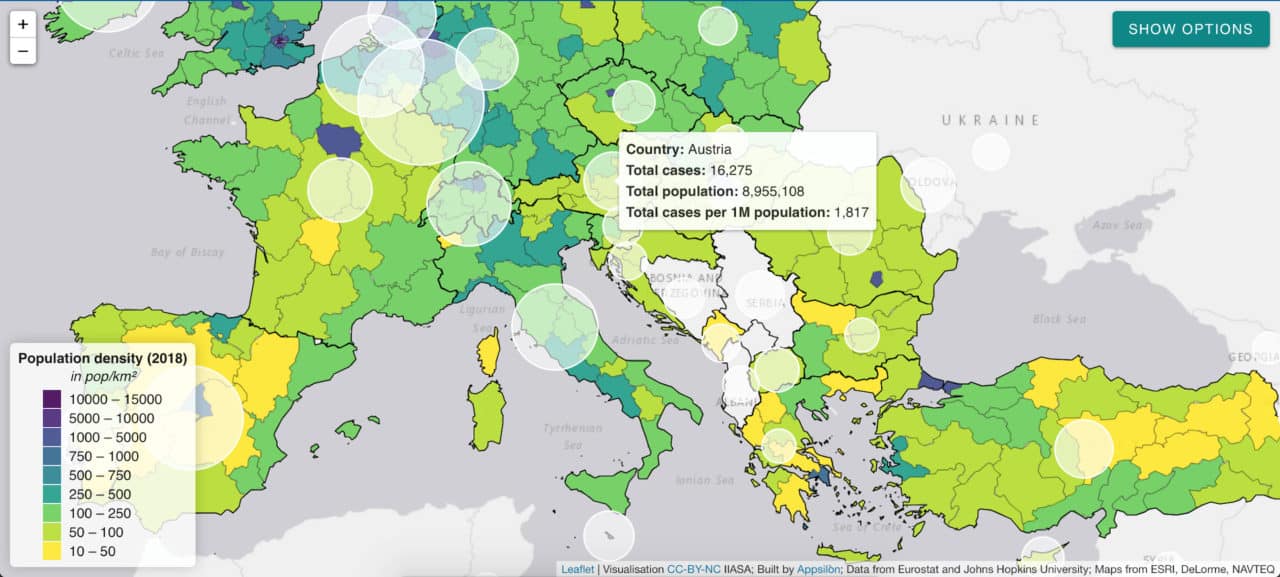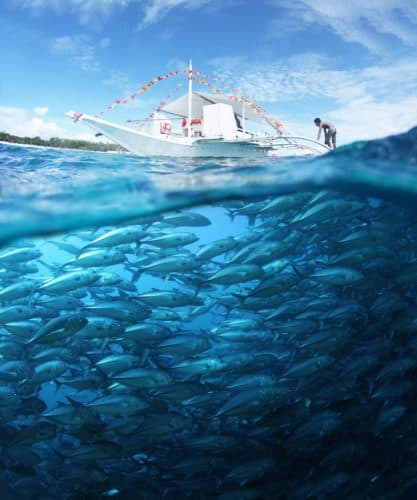Mar 10, 2021 | Communication, IIASA Network, Science and Policy, Women in Science
By Marie Franquin, External Relations Officer in the IIASA Communications and External Relations Department
Marie Franquin writes about her first six months as part of the IIASA Communications and External Relations team.
This year has certainly been a great challenge for all of us, migrating our lives online and our offices to the living-room. Last summer, I finished my PhD and was ecstatic to have found a job at IIASA that encompassed day-to-day work on my favorite skills: international stakeholder engagement, policy interface, and interacting with researchers, including early career ones!
All of these aspects were covered in the newly launched 2021-2030 IIASA Strategy that was published in the winter. My challenge remained to know how I could best apply my science to policy and research skills to contribute to these goals. How do I help a systems analysis research community move towards more impact and increasing stakeholder engagement?
It quickly became obvious that my position in the external relations team required multitasking and honing a series of skills. The first and top skill that I have kept developing for the past six months was interacting with international stakeholders from all over the world, which included not only our National Member Organization (NMO) representatives and researchers from these countries, but also IIASA researchers and alumni. Working at IIASA I have already gained experience in developing relationships with stakeholders of the research community all over the world.

© Swietlana Malyszewa | Dreamstime.com
The IIASA stakeholder community also sheds new light on the value of the institute’s expertise in systems analysis for building international scientific partnerships, whether it be formal ones with my colleague Sergey Sizov and his science diplomacy expertise, or by facilitating research partnerships between our NMO countries and IIASA researchers.
With my colleague Monika Bauer, I am also learning about the future of stakeholder engagement and how to build virtual communities, like she’s doing with IIASA Connect:
“We are building the global systems analysis network on IIASA Connect. This tool allows colleagues, alumni, the institute’s regional communities, and collaborators to directly engage with each other and take advantage of the institute’s international and interdisciplinary network. It is something completely new for the organization,” she explains.
Our recent partnership with the Strategic Initiatives (SI) Program was aimed at better understanding the IIASA NMO countries and their individual research priorities for the next decades. I learned about local challenges and strengths and how countries have managed to move forward as a nation or by working hand in hand with their neighbors.
Coming from a research background, I am fascinated by the insights I am gaining working with IIASA communications colleagues on how to promote research and its impacts. I particularly enjoyed working with Ansa Heyl, helping IIASA experts build their policy brief submissions for the recent T20 Italy call for abstracts. As part of my skillset and center of interest, I aim to apply my science to policy skills here at IIASA to support the researchers and impacts of the amazing work done across the institute.
Having mostly worked with and for early career researchers for several years, I remain sensitive to their needs for career development opportunities. I am therefore excited to work with colleagues in the institute’s Capacity Development and Academic Training (CDAT) program to further define and support research excellence at IIASA, especially in the very promising next generation of systems scientists.
Few workplaces are so well connected and offer so many opportunities to develop such a broad range of skills as the IIASA Communications and External Relations team. As we are working towards fulfilling the IIASA Strategy’s aim of strengthening partnerships, I look forward to continuing to interact with IIASA researchers and supporting the institute’s goals of making sure the work done at IIASA positively impacts society. So come and chat with me!
Note: This article gives the views of the author, and not the position of the Nexus blog, nor of the International Institute for Applied Systems Analysis.
Aug 11, 2020 | COVID19, Data and Methods, Science and Policy, Women in Science
By Sibel Eker, researcher in the IIASA Energy Program
IIASA researcher Sibel Eker explores the usefulness and reliability of COVID-19 models for informing decision making about the extent of the epidemic and the healthcare problem.

© zack Ng 99 | Dreamstime.com
In the early days of the COVID-19 pandemic, when facts were uncertain, decisions were urgent, and stakes were very high, both the public and policymakers turned not to oracles, but to mathematical modelers to ask how many people could be infected and how the pandemic would evolve. The response was a plethora of hypothetical models shared on online platforms and numerous better calibrated scientific models published in online repositories. A few such models were announced to support governments’ decision-making processes in countries like Austria, the UK, and the US.
With this announcement, a heated debate began about the accuracy of model projections and their reliability. In the UK, for instance, the model developed by the MRC Centre for Global Infectious Disease Analysis at Imperial College London projected around 500,000 and 20,000 deaths without and with strict measures, respectively. These different policy scenarios were misinterpreted by the media as a drastic variation in the model assumptions, and hence a lack of reliability. In the US, projections of the model developed by the University of Washington’s Institute for Health Metrics and Evaluation (IHME) changed as new data were fed into the model, sparking further debate about the accuracy thereof.
This discussion about the accuracy and reliability of COVID-19 models led me to rethink model validity and validation. In a previous study, my colleagues and I showed that, based on a vast scientific literature on model validation and practitioners’ views, validity often equates with how good a model represents the reality, which is often measured by how accurately the model replicates the observed data. However, representativeness does not always imply the usefulness of a model. A commentary following that study emphasized the tradeoff between representativeness and the propagation error caused by it, thereby cautioning against an exaggerated focus on extending model boundaries and creating a modeling hubris.
Following these previous studies, in my latest commentary in Humanities and Social Sciences Communications, I briefly reviewed the COVID-19 models used in public policymaking in Austria, the UK, and the US in terms of how they capture the complexity of reality, how they report their validation, and how they communicate their assumptions and uncertainties. I concluded that the three models are undeniably useful for informing the public and policy debate about the extent of the epidemic and the healthcare problem. They serve the purpose of synthesizing the best available knowledge and data, and they provide a testbed for altering our assumptions and creating a variety of “what-if” scenarios. However, they cannot be seen as accurate prediction tools, not only because no model is able to do this, but also because these models lacked thorough formal validation according to their reports in late March. While it may be true that media misinterpretation triggered the debate about accuracy, there are expressions of overconfidence in the reporting of these models, even though the communication of uncertainties and assumptions are not fully clear.

© Jaka Vukotič | Dreamstime.com
The uncertainty and urgency associated with pandemic decision-making is familiar to many policymaking situations from climate change mitigation to sustainable resource management. Therefore, the lessons learned from the use of COVID models can resonate in other disciplines. Post-crisis research can analyze the usefulness of these models in the discourse and decision making so that we can better prepare for the next outbreak and we can better utilize policy models in any situation. Until then, we should take the prediction claims of any model with caution, focus on the scenario analysis capability of models, and remind ourselves one more time that a model is a representation of reality, not the reality itself, like René Magritte notes that his perfectly curved and brightly polished pipe is not a pipe.
References
Eker S (2020). Validity and usefulness of COVID-19 models. Humanities and Social Sciences Communications 7 (1) [pure.iiasa.ac.at/16614]
Note: This article gives the views of the author, and not the position of the Nexus blog, nor of the International Institute for Applied Systems Analysis.
Jun 15, 2020 | COVID19, Data and Methods, Demography
By Tadeusz Bara-Slupski, Artificial Intelligence for Good initiative leader, Appsilon Data Science
Tadeusz Bara-Slupski discusses the Artificial Intelligence for Good initiative’s recent collaboration with IIASA to develop an interactive COVID-19 data visualization tool.

Number of hospital beds per 1000 population © IIASA
Public institutions rely on external data sources and analysis to guide policymaking and intervention. Through our AI for Good initiative, we support organizations that provide such inputs with our technical expertise. We were recently approached by IIASA to create a dashboard to visualize COVID-19 data. This builds on our previous collaboration, which had us deliver a decision-making tool for natural disaster risk planning in Madagascar. In this article, we provide an example of how to help policymakers navigate the ocean of available data with dashboards that turn these data into actionable information.
Data is useful information when it creates value…or saves lives
The current pandemic emergency has put an unprecedented strain on both public health services and policymaking bodies around the world. Government action has been constrained in many cases by limited access to equipment and personnel. Adequate policymaking can help to coordinate the emergency relief effort effectively, make better use of scarce resources, and prevent such shortages in the future. This, however, requires access to secure, timely, and accurate information.
Governments commission various public bodies and research institutes to provide such data both for planning and coordinating the response. For instance, in the UK, the government commissioned the National Health Service (NHS) to build a data platform to consolidate a number of data providers into one single source. However, for the data to be useful it must be presented in a way that is consistent with the demands of an emergency situation. Therefore, the NHS partnered with a number of tech companies to visualize the data in dashboards and to provide deeper insights. Raw data, regardless of its quality, is not useful information until it is understood in a way that creates value – or in this case informs action that could save lives.
IIASA approached us to support them in making their COVID-19 data and indicators more useful to policymakers. The institute’s research is used by policymakers around the world to make critical decisions. We appreciated the opportunity to use our skills to support their efforts by creating an interactive data visualization tool.
IIASA COVID-19 report and mapbook
Research indicates that while all segments of the population are vulnerable to the virus, not all countries are equally vulnerable at the same time. Therefore, there is a need for accurate socioeconomic and demographic data to inform the allocation of scarce resources between countries and even within countries.
IIASA responded to this need with a regularly updated website and data report: “COVID-19: Visualizing regional socioeconomic indicators for Europe”. The reader is introduced to a range of demographic, socioeconomic, and health-related indicators for European Union member countries and sub-regions in five categories:
- Current COVID-19 trends – information about the number of cases and effectiveness of policy response measures
- Demographic indicators – age, population density, migration
- Economic indicators – GDP, income, share of workers who work from home
- Health-related indicators – information about healthcare system capacity
- Tourism – number of visitors, including foreign
The indicators and data were chosen for their value in assisting epidemiological analysis and balanced policy formulation. Policymakers often face the challenge of prioritizing pandemic mitigation efforts over long-term impacts like unemployment, production losses, and supply-chain disruptions. IIASA’s series of maps and graphs facilitates understanding of these impacts while maintaining the focus on containing the spread of the virus.
Our collaboration – a dashboard for policymakers
Having taken the first step to disseminate the data as information in the form of a mapbook, Asjad Naqvi decided to make these data even more accessible by turning the maps into an interactive and visually appealing tool.
IIASA has previously approached Appsilon Data Science with a data visualization project, which had us improve the features and design of Visualize, a decision support tool for policymakers in natural disaster risk management. Building on this experience, we set out to assist Naqvi with creating a dashboard to deliver the data to end-users even faster.
The application allows for browsing through a list of 32 indicators and visualizing them on an interactive map. The list is not final with indicators being regularly reviewed, added, and retired on a weekly basis.

White circles indicate the number of cases per 1 million citizens.
The application will continue to provide the latest and most relevant information to track regional performance in Europe also in the post-pandemic phase:

The pandemic has a disproportionate impact on women’s employment and revealed some of the systemic inequalities.
Social distancing measures, for instance, have a large impact on sectors with high female employment rates. The closure of schools and daycare facilities particularly affects working mothers. Indicators such as female unemployment rate can inform appropriate remedial action in the post-COVID world and highlight regions of special concern like Castilla-La-Mancha in Spain.
Given the urgency of the pandemic emergency, we managed to develop and deploy this application within five days. We believe such partnerships between data science consultancies and research institutes can transform the way policymakers utilize data. We are looking forward to future collaborations with IIASA and other partners to help transform data into accessible and useful information.
This project was conducted as part of our Artificial Intelligence for Good initiative. The application is available to explore here.
Note: This article gives the views of the author, and not the position of the Nexus blog, nor of the International Institute for Applied Systems Analysis.
Nov 21, 2019 | Air Pollution, Environment, Food & Water, Indonesia, Women in Science
By Adriana Gómez-Sanabria, researcher in the IIASA Air Quality and Greenhouse Gases Program
Adriana Gómez-Sanabria discusses the results of a new study that looked into the impacts of implementing various technologies to treat wastewater from the fish processing industry in Indonesia.

© Mikhail Dudarev | Dreamstime.com
To reduce water pollution and climate risks, the world needs to go beyond signing agreements and start acting. Translating agreements and policies into action is however always much more difficult than it might seem, because it requires all players involved to participate. A complete integration strategy across all sectors is needed. One of the advantages of integrating all sectors is that it would be possible to meet different objectives, for example, climate and water protection goals in this case, with the same strategy.
I was involved in a study that assessed the impacts of implementing various technologies to treat wastewater from the fish processing industry in Indonesia when involving different levels of governance. This study is part of the strategies that the government of Indonesia is evaluating to meet the greenhouse gas mitigation goals pledged in its Nationally Determined Contribution (NDC), as well as to reduce water pollution. Although Indonesia has severe national wastewater regulations, especially in the fish processing industry, these are not being strictly implemented due to lack of expertise, wastewater infrastructure, budgetary availability, and lack of stakeholder engagement. The objective of the study was to evaluate which technology would be the most appropriate and what levels of governance would need to be involved to simultaneously meet national climate and water quality targets in the country.
Seven different wastewater treatment technologies and governance levels were included in the analysis. The combinations included were: 1) Untreated/anaerobic lagoons – where untreated means wastewater is discharged without any treatment and anaerobic lagoons are ponds filled with wastewater that undergo anaerobic processes – combined with the current level of governance. 2) Aeration lagoons – which are wastewater treatment systems consisting of a pond with artificial aeration to promote the oxidation of wastewaters, plus activated sludge focused solely on water quality targets with no coordination between water and climate institutions. 3) Swimbed, which is an aerobic aeration tank focusing mainly on climate targets assuming no coordination between institutions. 4) Upflow anaerobic sludge blanket (UASB) technology, which is an anaerobic reactor with gas recovery and use followed by Swimbed, and 5) UASB with gas recovery and use followed by activated sludge, which is an aerobic treatment that uses microorganisms forming particles that clump together. Both, 4 and 5 assume vertical and horizontal coordination between water and climate institutions at national, regional, and local level. It is important to notice that the main difference between 4 and 5 is the technology used in the second step. Two additional combinations, 6 and 7, are also proposed including the same technological combinations of 4 and 5, but these include increasing the level of governance to a multi-actor coordination level. The multi-actor level includes coordination at all institutional levels but also involves academia, research institutes, international support, and other stakeholders.
Our results indicate that if the current situation continues, there would be an increase of greenhouse gases and water pollution between 2015 and 2030, driven by the growth in fish industry production volumes. Interestingly, the study also shows that focusing only on strengthening capacities to enforce national water policies would result in greenhouse gas emissions five times higher in 2030 than if the current situation continues, due to the increased electricity consumption and sludge production from the wastewater treatment process. The benefit of this strategy would be positive for the reduction of water pollution, but negative for climate change mitigation. From our analyses of combinations 2 and 3 we learned that technology can be very efficient for one purpose but detrimental for others. If different institutions are, for example, responsible for water quality and climate change mitigation, communication between the institutions is crucial to avoid trade-offs between environmental objectives.
Furthermore, when analyzing different cooperation strategies together with a combination of diverse sets of technologies, we found that not all combinations work appropriately. For instance, improving interaction just within and between institutions does not guarantee proper selection and application of technologies. In this case, the adoption of the technology is not fast enough to meet the targets proposed in 2030, thus resulting in policy implementation failures. Our analyses of combinations 4 and 5 showed that interaction within and between national, regional, and local institutions alone is not enough to prevent policy failure.
Finally, a multi-actor cooperation strategy that includes cooperation across sectors, administrative levels, international support, and stakeholders, seems to be the right approach to ensure selection of the most appropriate technologies and achieve policy success. We identified that with this approach, it would be possible to reduce water pollution and simultaneously decrease greenhouse gas emissions from the electricity required for wastewater treatment. Analyzing combinations 6 and 7 revealed that multi-actor governance allows to simultaneously meet climate and water objectives and a high chance to prevent policy failure.
In the end, analyses such as the one shown here, highlight the importance of integrating and creating synergies across sectors, administrative levels, stakeholders, and international institutions to ensure an effective implementation of policies that provide incentives to make careful choices regarding multi-objective treatment technologies.
Reference:
Gómez-Sanabria A, Zusman E, Höglund-Isaksson L, Klimont Z, Lee S-Y, Akahoshi K, Farzaneh H, & Chairunnisa (2019). Sustainable wastewater management in Indonesia’s fish processing industry: bringing governance into scenario analysis. Journal of Environmental Management (Submitted).
Note: This article gives the views of the author, and not the position of the Nexus blog, nor of the International Institute for Applied Systems Analysis.
Oct 15, 2019 | IIASA Network, Science and Policy, South Africa
Bettina Greenwell, communications officer at IIASA, talks to Dorsamy (Gansen) Pillay, Deputy CEO: Research and Innovation Support and Advancement (RISA), National Research Foundation (NRF), and IIASA council member for South Africa, about the NRF’s statement on ethical research and scholarly publishing practices. The statement was jointly issued in August 2019 with South African partners within the National System of Innovation (NSI) in South Africa.

Dorsamy (Gansen) Pillay, Deputy CEO: Research and Innovation Support and Advancement (RISA), National Research Foundation (NRF), and IIASA council member for South Africa
What is ethics in research and why is it so important?
Research is a quest for truth. The research must be well conceptualized with a clear research question(s) which can lead to new knowledge. Good ethics and integrity dictate that the truth must be presented in its absolute form, and the findings need to be appropriately interpreted and should be reproducible.
South Africa was awarded the right to host the 7th World Conference on Research Integrity (WCRI) in 2021 in Cape Town – the first time it will be hosted on an African continent. Why is this statement important for the science community in South Africa?
Firstly, it is a privilege to host this conference and South Africa feels very honored. The statement on ethical research and scholarly publishing practices is an important contribution to this conference. We have noticed that South African academics and researchers, especially new and emerging researchers, are under a lot of pressure to publish their work for a variety of reasons. In some instances, ethical principles have been violated. This included the dissemination of research through predatory journals. However, this was not unique to South Africa only as other countries also faced similar challenges. The NRF as a science granting foundation felt compelled to respond to this challenge. The NRF sees itself as a custodian and guardian of research ethics and integrity. Through our peer-review processes, we ensure that research proposals for funding have been robustly interrogated, and the highest ethical principles upheld. As a consequence the NRF developed and issued a joint statement on ethical research and scholarly publications in collaboration with the Department of Science and Innovation (DSI), the Department of Higher Education and Training (DHET), the Council on Higher Education (CHE), the Academy of science of South Africa (ASSAf), Universities South African (USAf) and the NRF. In addition, the NRF has previously issued a statement on predatory publishing.
What do you think will be the key scientific challenges to face South Africa in the next few years? And how do you envision IIASA helping South Africa to tackle these?
There are several challenges, and some of the most pressing ones are poverty and inequality, population migration and unemployment. Given the systems analysis approach, we feel we can draw on IIASA’s expertise to address these challenges. IIASA has used South Africa as a laboratory for its population studies research over several years. It is now time to ensure that this research is translated into policies so that it may impact positively on society.
Housing is also a problem in South Africa. There is a lack of decent, affordable housing for people. The new IIASA strategic plan focuses on smart cities – this could play a role in addressing these housing challenges.
IIASA’s expertise is a systems analysis approach which can be applied to complex issues. The important part of the work is when scientific results are turned into policy – that’s when there is an actual, tangible societal benefit.
South Africa has been an IIASA member since 2007. What have been the highlights of the South Africa-IIASA membership until now?
We see the South Africa IIASA membership as a partnership, and many benefits have accrued through this partnership over the past decade. An example is the Southern African Young Scientists Summer Program (SA-YSSP), which was inspired by the success of the IIASA YSSP. This program ran from 2012 to 2015, and trained the next generation of young scientists.
Another example is the Southern African Systems Analysis Centre (SASAC) initiative, which focused on expanding systems analysis expertise in Southern Africa. Both initiatives were endorsed by the South African Department of Science and Innovation.
About NRF and Dorsamy (Gansen) Pillay
As an entity of the Department of Science and Technology (DST), the NRF promotes and supports research through funding, human resource development and the provision of National Research Facilities in all fields of natural and social sciences, humanities and technology. Dr Dorsamy (Gansen) Pillay is currently the Deputy Chief Executive Officer (DCEO): Research and Innovation Support and Advancement (RISA) of the National Research Foundation (NRF) of South Africa. His thirty-year career in research, teaching, management and leadership includes academic, management and leadership positions at the former University of Durban-Westville and at the Durban University of Technology. His research has focused on both prokaryotic and eukaryotic microorganisms, from human diseases to bacterial plant diseases with particular emphasis on elucidating the molecular architecture of the causal microorganisms with a view to understanding genetic diversity, extra-chromosomal elements and developing rapid disease diagnoses. He is currently Vice Chair of the IIASA Council.
Notes:
Please click on the link to read the statement on ethical research and scholarly publishing.
More information on IIASA and South Africa.
This article gives the views of the authors, and not the position of the Nexus blog, nor of the International Institute for Applied Systems Analysis.









You must be logged in to post a comment.